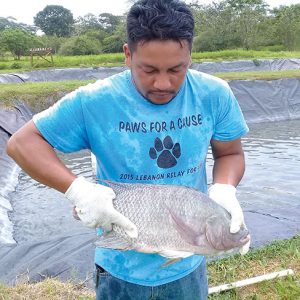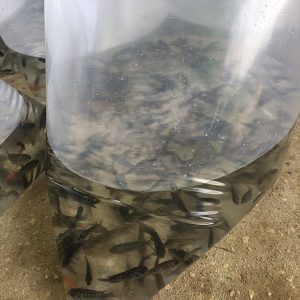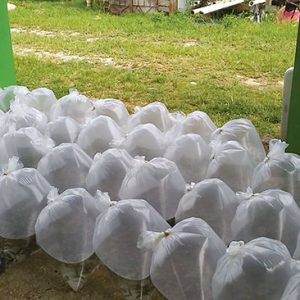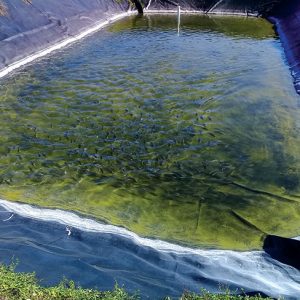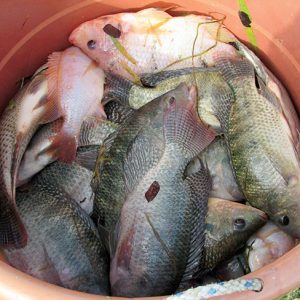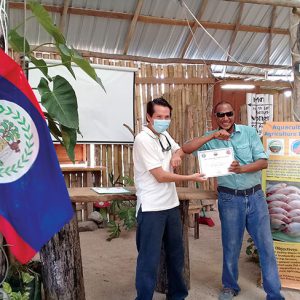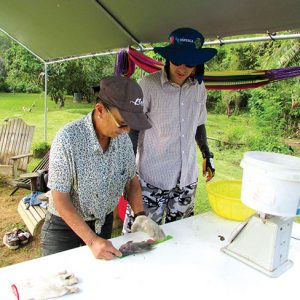
Features
Persevering through a pandemic
What does one do, when there is no longer access to fish feed? A situation the Tilapia Hatchery Centre’s staff-of-12 hoped they would never have to face.
September 16, 2021 By Catarina Muia
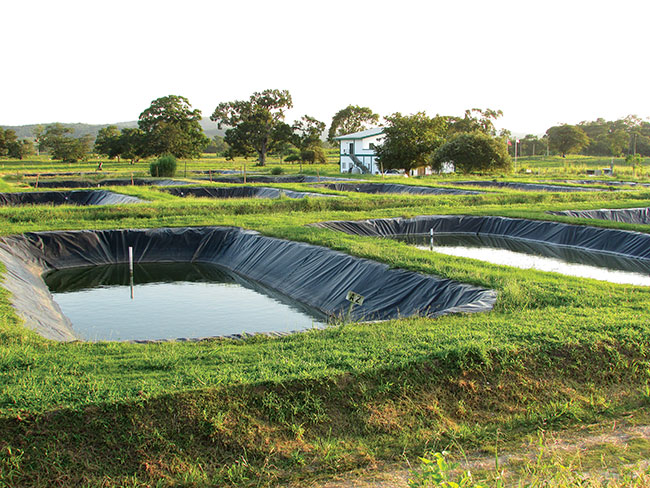 Sitting on a 13.3-acre piece of land, the Tilapia Hatchery Centre (THC), located in Belize, consists of 16 ponds, and 16 nursery tanks. Photos courtesy: Tilapia Hatchery Centre
Sitting on a 13.3-acre piece of land, the Tilapia Hatchery Centre (THC), located in Belize, consists of 16 ponds, and 16 nursery tanks. Photos courtesy: Tilapia Hatchery Centre Starting in late April 2020, the Tilapia Hatchery Centre (THC), located in the Cayo District of Belize, faced a challenging situation when the COVID-19 pandemic caused the border between Belize and Guatemala to close. For one month, THC couldn’t import any fish feed, and workers had to think quickly before their stock risked taking a hard health hit.
A sizeable space
On a piece of land that’s 13.3 acres, 50 per cent of the area is occupied by the THC, which consists of:
- a two-storey office building
- a feed shed
- 12 ponds (21m by 21m) for tilapia breeding;
- four ponds (24m by 24m) for grow-out;
- an outdoor, open-air nursery with 16 concrete nursery tanks (seven tons), and 12 smaller, concrete storing tanks;
- and a processing facility for workers to prepare and send the fish out for distribution.
The ponds hold two different breeds of tilapia popular in Belize: red tilapia and grey tilapia. “In each of our red tilapia breeding ponds, we have 140 breeders,” says Neri Bol, aquaculture technician in the Aquaculture Unit of the Belize Government’s Department of Agriculture, which runs the Tilapia Hatchery Centre. “When it comes to breeding, we have a three to one ratio, which is three females to one male,” Bol continues. “In the grey tilapia ponds, while it typically differs, we currently have a total of 130 breeders in each.” When it comes to grow-out, the centre keeps a total of 800 fingerlings in each of the four grow-out ponds.
Responsible for the harvest, are the THC’s field labourers. “We have many tasks to achieve around the hatchery, such as changing the water, feeding the stock, and harvesting,” says field labourer, Evral Trapp. “We’ll harvest once, wait about 14 to 15 days after, then harvest again.” Harvesting two times per month, the THC harvests a total of 24 times each year.
“In 2018 we produced 476,500 fry. Once sex reverse was completed, we sold 158,338 fingerlings to farmers,” Bol states. “In 2019 we produced 233,500 fry, and sold 118,362 fingerlings. Last year, in 2020, we produced 211,700 fry, and sold 113,416 fingerlings.” This year, from January to July, the centre has already sold 142,378 fingerlings. “I was surprised and impressed after seeing the calculations, especially after the decrease we saw in both the production and sales totals in 2020, due to COVID-19.”
A need for feed
With only seven of the 12 staff members directly involved with the THC’s day-to-day responsibilities, Bol explains that the lack of manpower caused by the pandemic put them in a tight spot.
“In 2020, we never had enough manpower. We had to go into a rotation period where only a certain number of staff members could work at a time,” he explains. Additionally, as the THC’s commercial fish feed is provided by a company located in Guatemala, the staff was taken by surprise and had to do some quick thinking, once the borders closed.
“When the pandemic started, we didn’t even think to worry about feed. We didn’t think the factories would close, or people would stop going into work and feed would stop being produced, so we just kept feeding the fish like normal,” recalls Joe Saravia, aquaculture technician for the Ministry of Agriculture. “But then, it hit us; we realized there was no feed. My supervisor quickly thought of alternative feeding.”
Several ideas were put on the table, as research was conducted on hormone treatment, feeding, growth, and water quality. In the end, three different feed types for tilapia were created, with protein contents of 28 per cent, 32 per cent, or 38 per cent. “We used both plant- and animal-based protein in the feed,” Saravia explains. Soybean meal was used as the plant-based protein and meat meal was used as the animal-based protein. “We don’t have access to, nor do we produce fish meal here in Belize, so we use poultry waste to produce meat meal.” Holding the meals together was flour and to ensure the fish had a well-balanced diet, the feed further consisted of wheat meal, rice bran, vitamins, and minerals. “Additionally, we used salt in our feed as it purges the tilapia, which is a freshwater fish, of any disease or bacteria that may be trying to attack inside.” The THC produced between 1,000 to 1,500 pounds of alternative feed for the fish, during the month when food couldn’t be imported.
Once the feed had been produced, the staff needed to train the fish to eat the alternative feed. “Unlike commercial feed, which floats, our feed sinks,” says Saravia. “In Belize we use a pelletizer machine, which causes the feed to sit at the bottom. We needed to stand at the side of the tank to feed them so they could see the food sink to the bottom, and slowly they broadcasted that throughout the pond.”
As a result of the lack of feed, as well as the time needed to train the fish once alternative feed had been produced, the THC saw a loss in production, and its fish had lost weight. However, no other health risks or changes were noted in the fish. “If I change your diet from one day to the next, you might not eat the same amount right away,” Saravia points out. “But slowly, you get used to it and you’ll start to eat the same amount again.”
Along with training the fish how to eat again and mitigating the various challenges imposed by the lockdown, the THC’s aquaculture technicians had to continue carrying out their regular, day-to-day tasks. At the THC, technicians inspect the ponds daily, monitor oxygen levels, check fish feed, feed the fry and fingerlings, and fix service pumps. Another major part of their responsibilities, which takes place offsite, is the staff’s extension work. This consists of visiting and assisting all the national farmers.
Assisting nation-wide
The THC was first established as a joint project between the governments of Belize and Taiwan in 2012 and it has since become a great source to boost the Belize economy, and promote the aquaculture and agriculture industries. What started out as a single, government-run tilapia hatchery, has turned into 170 small- to medium-scale, privately-owned fish farms across the country.
“While the main concentration of production takes place here in the western districts, all six of Belize’s districts farm and produce tilapia,” says Bol. Following the COVID-19 pandemic, he noticed there was a spike in interest nation-wide, noting that people see it as a way to persevere and hold their own during times of crises.
However, with so many farms nation-wide, the THC’s aquaculture technicians face busy and tight schedules, coordinating their daily tasks at the THC, with their extension work of visiting the national farms. Since the THC, as well as the privately-owned fish farms do not have access to automated monitoring systems or equipment, any monitoring or testing must be done manually, with kits supplied to the THC.
“When we visit the farmers, we measure the growth of their fish, we make recommendations for feeding, water quality, stocking, conservation, and construction, and we can also assist with farmers’ budgeting and capital needed,” Saravia explains.
When going from farm to farm, the technicians must ensure each pond’s water quality is good, and use a water quality test kit that monitors for ammonia, oxygen, pH, and salinity.
“We also don’t have access to equipment necessary to perform research on things like microbiology, diseases or fungus, but we work hand-in-hand with the Belize Agricultural Health Authority (BAHA). If we ever want to perform tests on a disease or something of that matter, they will do it for us.”
Moving forward
Compared to 2020, this year has already seen a significant increase in fingerling sales for the THC. For the THC staff, it’s a sign that the aquaculture industry in Belize will continue to expand.
Looking to lead the growth and sustainability of the Belize aquaculture industry, the THC will also continue to expand, starting with its new processing facility, which completed construction in 2017. While it was completed almost four years ago, it took about a year and a half for the staff to be fully trained and have the entire process running smoothly. “At first we were preparing and packaging whole fish,” Saravia recalls. “Then, we received a one-day training session to learn how to fillet the fish. This was difficult because you need to be careful of losing meats, and need to ensure you are cutting in the right places. It took a lot of practice.”
Staff were required to participate in food hander’s training to obtain a food hander’s licence. “We had an officer from BAHA come in and give recommendations on our processing facility. He trained us on the amount of chlorine that needed to be in the water for processing, as well as how to store our cleaning equipment. At the end, it was a lot of coordination and cooperation with different organizations.”
Additionally, the THC is looking to expand by constructing two to three more grow-out ponds to keep up with the market demands for tilapia. “To be honest, tilapia production isn’t difficult to handle and in our district the product is moving relatively quickly, as tilapia consumption has increased,” Bol admits.
Belize’s tilapia consumption was originally quite low, as people would often associate tilapia with the term, ‘mudfish’. As the THC began to grow-out though, staff participated in public events and offered the filleted product to attendees. “People started tasting it and slowly began to realize that the taste isn’t what they had expected. Slowly, they started to gain interest,” Bol exclaims. “And it has only increased. I definitely see the production and consumption of tilapia continuing to grow, year after year.”
Print this page
Advertisement
- GenoMar Genetics Vietnam announces successful fingerling shipment from new production base
- Nofima researchers win animal research prize
